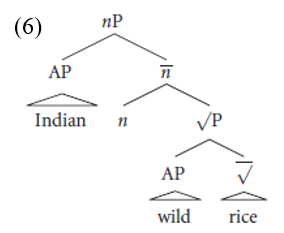


 Grammar
Grammar
 Tenses
Tenses
 Present
Present
 Past
Past
 Future
Future
 Parts Of Speech
Parts Of Speech
 Nouns
Nouns
 Verbs
Verbs
 Adverbs
Adverbs
 Adjectives
Adjectives
 Pronouns
Pronouns
 Pre Position
Pre Position
 Preposition by function
Preposition by function 
 Preposition by construction
Preposition by construction
 Conjunctions
Conjunctions
 Interjections
Interjections
 Grammar Rules
Grammar Rules
 Linguistics
Linguistics
 Semantics
Semantics
 Pragmatics
Pragmatics
 Reading Comprehension
Reading Comprehension|
Read More
Date: 2025-03-26
Date: 2024-01-22
Date: 3-3-2022
|
Idiomatic adjectives
Similarly, Marantz (2001) argues that the n level is the level of lexical idiosyncracy, so that idiomatically combined adjectives must attach below it. Expressions like those in (1) are illustrations; wild rice is a species of rice (zizania palustris), and need not have the properties conventionally associated with wildness. This contrasts, for example, with wild tomato, which has no idiomatic association and so would refer to an uncultivated (or ill-behaved, etc.) tomato. The idiom persists even when wild rice is modified by another adjective, such as Minnesotan, so that Minnesotan wild rice could be zizania palustris, when grown inMinnesota, for example.1 However, if an adjective is inserted below wild, as in wild Minnesotan rice, the idiomatic reading is lost, and the rice must be conventionally “wild” (in the case of rice, this would most likely mean uncultivated).

Along the same lines, nervous system is a kind of idiom, as is French toast; if regularly merged, compositional adjectives can only be merged outside nP, and these idiomatic adjectives are merged below, then the regular adjective cannot appear in between the idiomatic adjective and the noun.

Note that under the right circumstances, idioms in general can be disrupted by adjoined material. For example, ply X’s trade means “do X’s usual work”; it can be applied to activities in which the word trade would not be used otherwise, for example as in (4).
(4) A team of young filmmakers plied their trade aquarium.
Even part from the status of the possessive pronoun and the tense on the verb, an idiomatic noun like trade here can easily be modified by adjectives.
(5) A team of young filmmakers plied their glamorous trade at the aquarium.
Thus, it is not the case that idioms cannot be interrupted by non-idiomatic material (Nunberg et al. 1994; Svenonius 2005). Instead, if A can only have an idiomatic meaning in NP when it is merged below n, and if non-idiomatic A’s must be merged above n, then the right results are achieved (in the diagram I depict the root as category-less, following Marantz; it could also be depicted as category N, as elsewhere in this chapter).

1 A–N idioms can be distinguished from A–N compounds on the basis of stress; see e.g. Liberman and Sproat (1992). Compare the A–N idiom wild ríce to the A–N compound wíld man.
|
|
|
|
دخلت غرفة فنسيت ماذا تريد من داخلها.. خبير يفسر الحالة
|
|
|
|
|
|
|
ثورة طبية.. ابتكار أصغر جهاز لتنظيم ضربات القلب في العالم
|
|
|
|
|
|
|
قسم شؤون المعارف ووفد من جامعة البصرة يبحثان سبل تعزيز التعاون المشترك
|
|
|